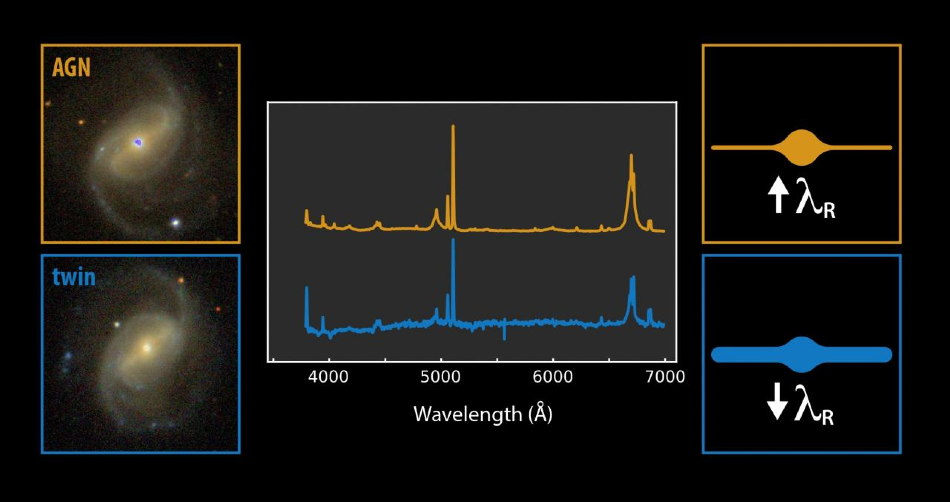Aug 3 2020
After evaluating the differences between the disks of many pairs of active and non-active spiral galaxies, a study reached a conclusion that the rotational movement of the stars in the former disks is relatively more important.
 Image illustrating the comparison between an active spiral galaxy (orange box) and its non-active twin (blue box). Image Credit: Gabriel Pérez Díaz, SMM (Institute of Astrophysics of the Canary Islands [IAC]).
Image illustrating the comparison between an active spiral galaxy (orange box) and its non-active twin (blue box). Image Credit: Gabriel Pérez Díaz, SMM (Institute of Astrophysics of the Canary Islands [IAC]).
The study, headed by scientists from the Institute of Astrophysics of the Canary Islands (IAC), was recently accepted for publication in the Astronomy & Astrophysics Letters journal. It offers the first proof for large-scale dynamical variations that exist between non-active and active galaxies in the local universe.
The astronomers who took part in this study are from IAC, the University of La Laguna (ULL), the National Autonomous University of Mexico (UNAM), the Complutense University of Madrid (UCM), and the Institute of Astrophysics of Andalusia (IAA).
Evidence shows that the giant black holes present at the heart of many galaxies have a fundamental effect on their evolution. The black hole in some of these galaxies is ingesting the material that encloses it at an extremely high rate, generating a huge amount of energy. In such cases, the galaxy is said to have an active nucleus (AGN).
Initially, the material feeding the AGN should be far away from the nucleus, in the galaxy disk, revolving around its center. But it is believed that this gas could have been “braked” in one way or another to fall into the central zone—a process called loss of angular momentum.
Studying the mechanisms which control the relation between the active nucleus and the rest of the galaxy is necessary to understand how these objects form and evolve, and to be able to throw light on this question we need to compare active and non-active galaxies. With this purpose, the main idea of my doctoral thesis is centred on the study and comparison of galaxies which are almost twin, but with the difference being nuclear activity.
Ignacio del Moral Castro, Study First Author and Doctoral Student, Institute of Astrophysics of the Canary Islands and University of La Laguna
In this study, comparisons were made between the dynamics of the galactic disks of numerous active and non-active pairs.
The team made use of data obtained from the CALIFA (Calar Alto Legacy Integral Field Area) survey. This includes spectroscopic information across complete two-dimensional (2D) fields for over 600 galaxies, captured at Almería-based Calar Alto Observatory. This data helps observe almost the whole of every galaxy so that its universal properties can be analyzed.
Novel Methodology
Earlier, the process used in many studies involved the detection of a sample of active galaxies inside the scope of a large survey, which were subsequently evaluated against the remaining galaxies in the survey having analogous characteristics that do not exhibit nuclear activity.
But this time, a new method was employed by the team. The scientists carried out one-to-one comparisons. Within the CALIFA sample, they initially detected active spiral galaxies, and for each of these galaxies, they searched for a non-active galaxy that had corresponding global characteristics, that is, with the same amount of orientation, brightness, mass, etc. and extremely analogous in appearance.
With the help of this technique, the researchers proposed two situations to elucidate the dynamical variations that exist between non-active and active galaxies.
In the first scenario, the explanation is that it is the trace of the angular momentum transfer that occurs between the gas, which, in turn, has fallen into the middle and the material, which continues to stay in the disk.
The second scenario attributes the variation to the infall of gas from outside, through the capture of minute neighboring satellite galaxies, in which case, such a capture should take place more often in the active galaxies. With this outcome, the two scenarios are well-matched and are not mutually exclusive.
The result surprised us; we really didn’t expect to find this type of differences on a large scale, give that the duration of the active phase is very short in comparison with the lifetime of a galaxy, and with the time needed to produce morphological and dynamical changes.
Begoña García Lorenzo, Study Coauthor and Researcher, Institute of Astrophysics of the Canary Islands
“Up to now we thought that all galaxies go through active phases during their lifetimes, but this result could mean that this is not the case, which would imply a major change to current models,” concluded Cristina Ramos Almeida, the study’s coauthor and also an IAC scientist.
Journal Reference:
Del Moral-Castro, I., et al. (2020) Larger λR in the disc of isolated active spiral galaxies than in their non-active twins. Astronomy & Astrophysics Letters. doi.org/10.1051/0004-6361/202038091.